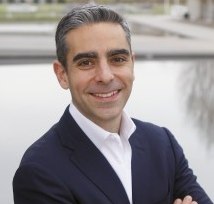PayPal President David Marcus held an informal sit-down with reporters today in San Francisco to address the recent shopping activity over the holidays, PayPal’s strategy on data and mobile, and the potential for the company to take a stake in in-store payments.
The payments giant said earlier today that mobile payments on Cyber Monday were already up 196 percent, and Marcus confirmed that it’s been an “amazing shopping weekend,” for PayPal. “The fascinating thing is the behavior change of people pre-shopping and buying on mobile.”
He adds that PayPal’s price-matching promotion has had a material impact on sales, and the company is seeing people choose PayPal over other payments methods for the incentive. He said that the lion’s share of PayPal checkout is being done via the mobile web as opposed to within apps.
Addressing PayPal’s Square competitor, PayPal Here, Marcus said that the technology and mobile payments device is seeing high rates of adoption, and that globally the product has been growing fast in terms of transaction amounts.
To address the mid-size-to-larger retailer, PayPal has debuted a number of custom in-store payments integrations, which can be seen at Home Depot, Abercrombie & Fitch and other mid-size merchants around the world. Marcus revealed that PayPal’s in-store payments option is currently available at 17,000 locations. PayPal hasn’t been doing much marketing for these new partnerships, but may do more once the recently announced deal with Discover launches early next year. “Discover will light up millions of new locations for PayPal’s in-store payments experience,” Marcus says.
PayPal will also be looking at helping to provide additional consumer credit when necessary, and has big plans to keep its new digital wallet “open,” with the launch of new APIs next year.
Speaking to the overall payments experience in-store, Marcus explains that some companies who are simply focused on payments in this arena will ultimately fail. “It’s about providing an entire shopping experience and ensuring people get relevant offers for what they are buying,” he says. “And that doesn’t happen unless you have data.”
It’s clear that leveraging data in a meaningful way is a major strategy for PayPal, as it moves into the New Year. Marcus says the company has around five petabytes of purchase data from its 117 million active users, and as long as users are willing to share this data, the company is in a good position to start using it to help businesses and consumers.
Part of this will involve building a strong database for businesses to access. A business could tell PayPal what its typical customer looks like and be able to access additional potential customers based on this profile data.
Geofencing is also an area where we’ll see PayPal dive deep, using Where’s technology. These tests will be announced and rolled out widely early next year.
Besides homing in on parsing through consumer data, another focus for PayPal is to help small merchants grow their businesses using PayPal. Marcus says that the company is looking at a number of ways to help reach small businesses, including installment plans. PayPal recently unveiled a new offering for businesses to sell items with a six-payment installment plan. Several sites and businesses who have been doing this are already seeing sales growing by 20 percent, says Marcus.
As for the health of the company, Marcus acknowledges that the recent layoffs in PayPal’s product and engineering groups were “painful, but needed.” “The organization is recovering well, and the vast majority of people at PayPal believe we are in a better place as a flatter org.”
PayPal is still hiring, but just not as fast as it used to. And the company is looking to hire more designers and younger talent, with the hope of bringing new creative blood into the organization. The culture is already changing, he says. For example, an employee of BillMeLater suggested that PayPal defer payments for users until after HurricaneSandy to give people time who may not have had Internet access to pay their monthly bills from the service. This type of suggestion would previously have taken a lot of time to process, explains Marcus, but with the new org, this only took a few hours for implementation. And we’ll see more acquisitions in the future, as well.
Interestingly, Marcus chose to meet reporters today at Starbucks, a brand which kicked off a major deal with PayPal competitor Square. But Marcus is confident that PayPal’s current product strategy, and the company’s continued growth and success, is going to help keep the payments organization relevant and popular with consumers. “We have big plans to create value for consumers,” he says, reaffirming that the company’s well-positioned for the competitive environment of both digital and mobile payments.
While it’s clear that the company has a lot of work ahead of it when it comes to implementing all of the ideas and tests mentioned above, it’s good to see that Marcus is optimistic and open about the future.
